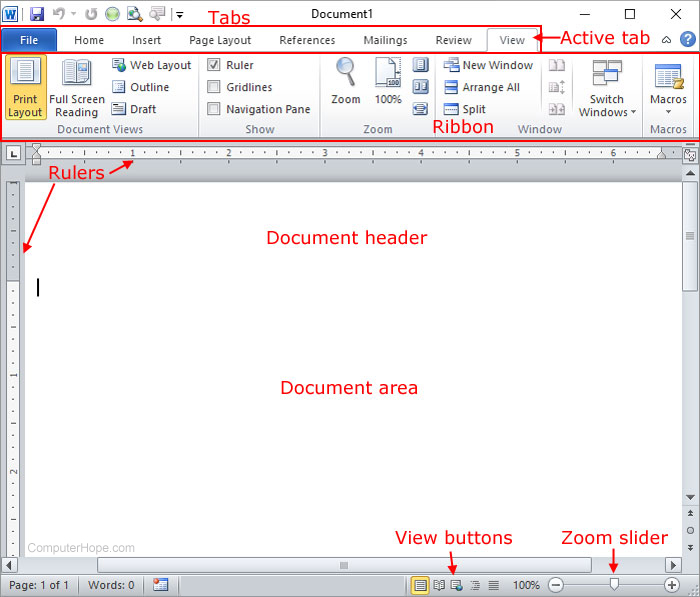LESSON 3: PARTS AND FEATURES OF WORD PROCESSING
Parts Of Word Processing
````````````````````
In a word processor, you are presented with a blank white sheet as shown below. The text is added to the document area and after it has been inserted formatted or adjusted to your preference. Below is an example of a blank Microsoft Word window with areas of the window highlighted.
Features of a word processor
Unlike a basic plaintext editor, a word processor offers dozens of additional features that can give your document or other text a more professional appearance. Below is a listing of some of the most popular features of a word processor.
Note
Some more advanced text editors can perform some of these functions.
- Text formatting - Changing the font, font size, font color, bold, italicizing, underline, etc.
- Copying, cutting, and pasting - Once text has been entered into a documented it can be copied or cut and pasted anywhere in the current document or another document.
- Multimedia - Insert clip art, charts, images, pictures, and video into a document.
- Spelling and Grammar - Checks for spelling and grammar errors in a document.
- Adjust the layout - Capable of modifying the margins, size, and layout of a document.
- Find - Word processors give you the ability to quickly find any word or text in any size of the document.
- Search and Replace - You can use the Search and Replace feature to replace any text throughout a document.
- Indentation and lists - Set and format tabs, bullet lists, and number lists.
- Insert tables - Add tables to a document.
- Word wrap - Word processors can detect the edges of a page or container and automatically wrap the text using word wrap.
- Header and footer - Being able to adjust and change text in the header and footer of a document.
- Thesaurus - Look up alternatives to a word without leaving the program.
- Multiple windows - While working on a document, you can have additional windows with other documents for comparison or move text between documents.
- AutoCorrect - Automatically correct common errors (e.g., typing "teh" and having it autocorrected to "the").
- Mailers and labels - Create mailers or print labels.
- Import data - Import and format data from CSV, database, or another source.
- Headers and footers - The headers and footers of a document can be customized to contain page numbers, dates, footnotes, or any text of all pages of the document or specific pages.
- Merge - Word processors allow data from other documents and files to be automatically merged into a new document. For example, you can mail merge names into a letter.
- Macros - Setup macros to perform common tasks.
- Collaboration - More modern word processors can help multiple people work on the same document at the same time.
Comments
Post a Comment